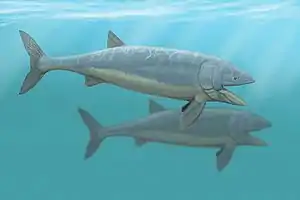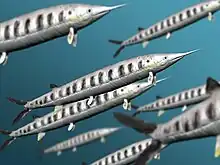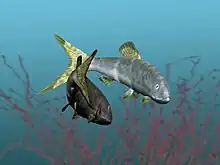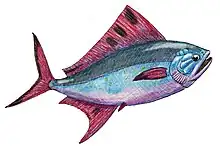Pachyrhizodus
Pachyrhizodus is an extinct genus of ray-finned fish that lived during the Cretaceous to Paleocene[1] in what is now Europe, North America, South America, and Oceania. Many species are known, primarily from the Cretaceous of England and the midwestern United States.[2]
| Pachyrhizodus | |
|---|---|
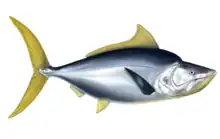 | |
| Restoration of P. caninus | |
| Scientific classification | |
| Domain: | Eukaryota |
| Kingdom: | Animalia |
| Phylum: | Chordata |
| Class: | Actinopterygii |
| Order: | †Crossognathiformes |
| Family: | †Pachyrhizodontidae |
| Genus: | †Pachyrhizodus Dixon, 1850 |
| Type species | |
| †Pachyrhizodus basalis Dixon, 1850 | |
| Other species | |
| |
History and discovery

Pachyrhizodus fossils were first collected from Cambridgeshire, England in the 1840s and were very fragmentary, only a partial maxilla (SMB.9097) and were described as a species of Raphiosaurus in 1842 by Richard Owen. The type remains of Pachyrhizodus consisted of a maxilla (BMNH 49014) from the Lower Cretaceous of Sussex, England and was originally thought to be a mandible that Louis Agassiz dubbed Pachyrhizodus in 1850,[3] with Frederick Dixon creating the species name basalis for the specimen.[3] Over the next few years, many Pachyrhizodus species would be named only from England until in 1872, Edward Drinker Cope described large remains from the Smoky Hill Chalk of Kansas of several new species.[4] During the 19th century, several complete and partial skeletons of Pachyrhizodus were collected from England, many of which belonging to P. basalis and P. subulidens.[2] In 1899, Alban Stewart described the mandibles of another species, P. minimus, from Kansas and it is the most commonly discovered species of Pachyrhizodus.[5][6] Since the 19th century, many complete skeletons and species have been described from many regions.[7][8] P. caninus specifically has been discovered in the United States, Mexico, and New Zealand.[9][10][8]
References
- Cope, K. H., Utgaard, J.E., Masters, J.M., and Feldmann, R., 2005, The fauna of the Clayton Formation (Paleocene, Danian) of southern Illinois: A case of K/P survivorship and Danian recovery: Bulletin of the Mizunami Fossil Museum, v. 32, p. 97–108.
- Forey, P. L. (1977). The osteology of Notelops Woodward, Rhacolepis Agassiz and Pachyrhizodus Dixon (Pisces: Teleostei), Bull. Brit. Mus. Nat. Hist. (Geol.), 28, 125–204.
- Dixon, F. (1850): Geology and Fossils of the Tertiary and Cretaceous Formations of Sussex. – 422 pp.; London (Longman, Brown, Green & Longmans).
- Cope, E. D, 1872, On the families of fishes of the Cretaceous Formation of Kansas: Proceedings of the American Philosophical Society, v. 12, p. 327-357.
- Stewart, A. (1899). Pachyrhizodus minimus, a new species of fish from the Cretaceous of Kansas. Kansas University Quarterly, 8(1), 37-38.
- Everhart, M. J., (2005) Oceans of Kansas: A Natural History of the Western Interior Sea. Indiana University Press, Bloomington, 220 p.
- Bartholomai, A. (1969). The Lower Cretaceous elopoid fish Pachyrhizodus marathonensis (Etheridge Jr.). Stratigraphy and Palaeontology. Australian National University Press, Canberra, 249-263.
- Giersch, S., Frey, E., Stinnesbeck, W., & González González, A. H. (2010). Pachyrhizodus caninus Cope, 1872 (Teleostei, Crossognathiformes) from the early Turonian of Vallecillo (Mexico). Neues Jahrbuch für Geologie und Paläontologie, Abhandlungen, 258, 219-228.
- Wiffen, J. (1983). "The first record of Pachyrhizodus caninus Cope (Order Clupeiformes) from the Late Cretaceous of New Zealand". New Zealand Journal of Geology and Geophysics. 26 (1): 109–119. doi:10.1080/00288306.1983.10421527. ISSN 0028-8306.
- Shimada, K. (2015). Body form and paleoecology of the large Late Cretaceous bony fish, Pachyrhizodus caninus. Cretaceous Research, 52, 286-291.
Bibliography
- Bazzi, Mohamad; Elisabeth Einarsson, and Benjamin P. Kear. 2015. Late Cretaceous (Campanian) actinopterygian fishes from the Kristianstad Basin of southern Sweden. Geological Society of London, Special Publications 434. 277–292. . doi:10.1144/SP434.5
- Páramo Fonseca, María Euridice. 2001. Los peces de la familia Pachyrhizodontidae (Teleostei) del Turoniano del Valle Superior del Magdalena. Boletín Geológico 39. 51–83. .
